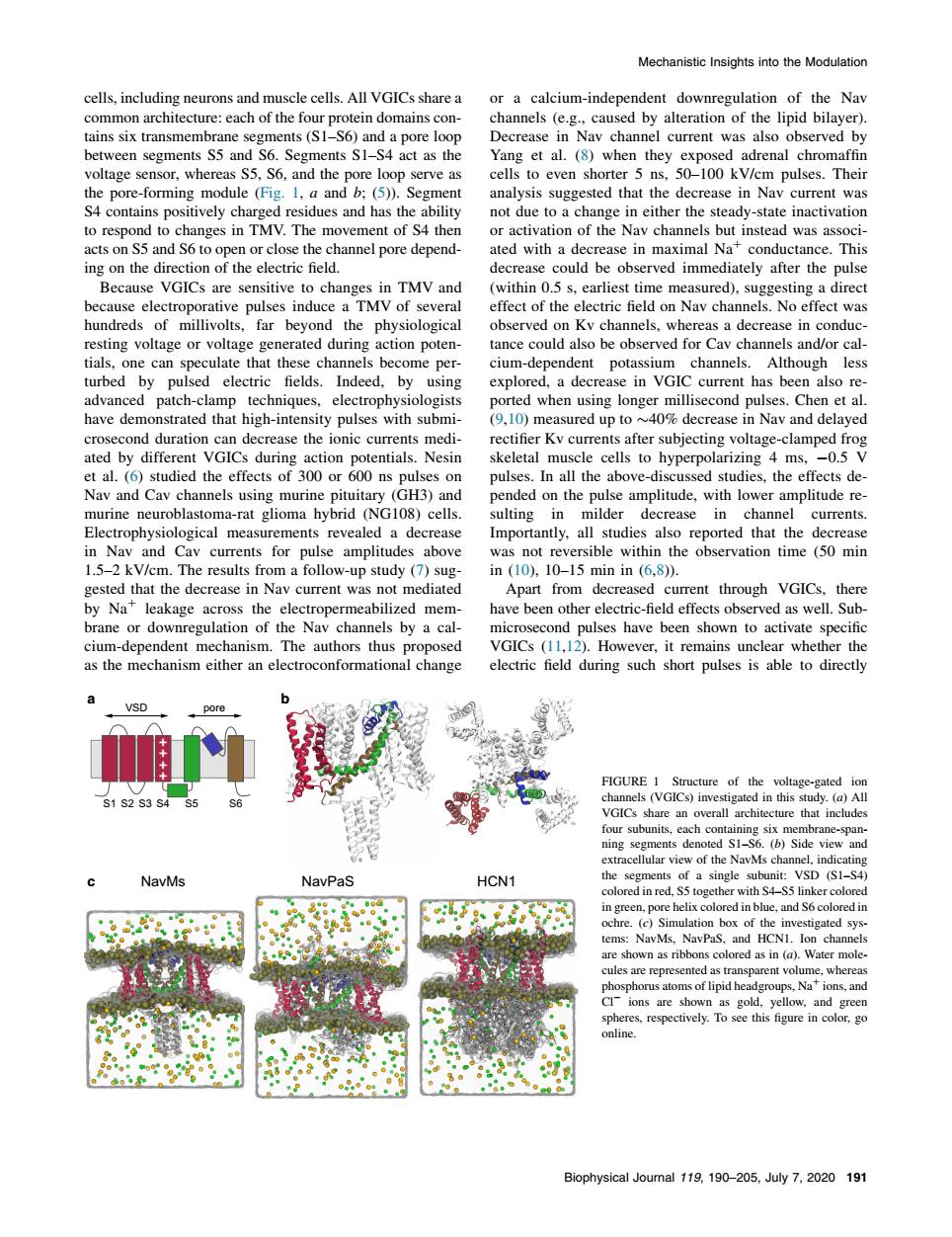正在加载图片...

Mechanistic Insights into the Modulation cells,includingneu ons and muscle cells.All VGICs share calcium-independent dow ulation of the Na on archite 一amsncaehothcogPoaae els(eg. caused by alteration of the lipid hilaver Decrease in Nav channel current was also observed by between segments S5 and S6.Segments S1-S4 act as the voltage s r.wher S6.and the d :as ns. m pulses.The esidues and has the not due to a change to respond to changes in TMV.The movement of S4 then or activation of the Nav channels but instead was associ conductance.This ing on the di the e tc n ative effect of the alec c field on Nay cha hundreds of millivolts,far beyond the physiological observed on ky channels.whereas a decrease in conduc resting voltage or voltage generated during action poten tance could also be observed for Cav channels and/or cal ele b cium-depen advanced patch-clamp techniaue rted when using longer millisecond pulses.Chen et al. have demonstrated that high-intensity pulses with submi crosecond duration can decrease the ionic currents medi (10 m rectifier Kv currents after subjecting voltage- clamped frog ated by 20 on all t to hyperpolan g 4 ms Nay and cay channels usin (GH3)and nded on the pulse amplitude,with lower murine neuroblastoma-rat glioma hybrid (NG10)cells. sulting in milder decrease in channel currents Electrophysiological measurements led a decrease Importantly.all 15-2d for pu ampl in me (50 in gested that the decrease in Nay current was not mediated Anart from decreased current through vGlcs ther by Na leakage across the electropermeabilized mem have been other electric-field effects observed as well.Sub- rane or downregulation of the Nav channels by a cal nd pulses have been shown toactivate specifi it remain of th 61s2s3 in thi 51-56 (h)Side vicw lular view of th NavMs HCN1 with S4-S box of th s rib orus toms of lipid h Biophysical Journal 119.190-205.July 7.2020 191cells, including neurons and muscle cells. All VGICs share a common architecture: each of the four protein domains contains six transmembrane segments (S1–S6) and a pore loop between segments S5 and S6. Segments S1–S4 act as the voltage sensor, whereas S5, S6, and the pore loop serve as the pore-forming module (Fig. 1, a and b; (5)). Segment S4 contains positively charged residues and has the ability to respond to changes in TMV. The movement of S4 then acts on S5 and S6 to open or close the channel pore depending on the direction of the electric field. Because VGICs are sensitive to changes in TMV and because electroporative pulses induce a TMV of several hundreds of millivolts, far beyond the physiological resting voltage or voltage generated during action potentials, one can speculate that these channels become perturbed by pulsed electric fields. Indeed, by using advanced patch-clamp techniques, electrophysiologists have demonstrated that high-intensity pulses with submicrosecond duration can decrease the ionic currents mediated by different VGICs during action potentials. Nesin et al. (6) studied the effects of 300 or 600 ns pulses on Nav and Cav channels using murine pituitary (GH3) and murine neuroblastoma-rat glioma hybrid (NG108) cells. Electrophysiological measurements revealed a decrease in Nav and Cav currents for pulse amplitudes above 1.5–2 kV/cm. The results from a follow-up study (7) suggested that the decrease in Nav current was not mediated by Naþ leakage across the electropermeabilized membrane or downregulation of the Nav channels by a calcium-dependent mechanism. The authors thus proposed as the mechanism either an electroconformational change or a calcium-independent downregulation of the Nav channels (e.g., caused by alteration of the lipid bilayer). Decrease in Nav channel current was also observed by Yang et al. (8) when they exposed adrenal chromaffin cells to even shorter 5 ns, 50–100 kV/cm pulses. Their analysis suggested that the decrease in Nav current was not due to a change in either the steady-state inactivation or activation of the Nav channels but instead was associated with a decrease in maximal Naþ conductance. This decrease could be observed immediately after the pulse (within 0.5 s, earliest time measured), suggesting a direct effect of the electric field on Nav channels. No effect was observed on Kv channels, whereas a decrease in conductance could also be observed for Cav channels and/or calcium-dependent potassium channels. Although less explored, a decrease in VGIC current has been also reported when using longer millisecond pulses. Chen et al. (9,10) measured up to 40% decrease in Nav and delayed rectifier Kv currents after subjecting voltage-clamped frog skeletal muscle cells to hyperpolarizing 4 ms, 0.5 V pulses. In all the above-discussed studies, the effects depended on the pulse amplitude, with lower amplitude resulting in milder decrease in channel currents. Importantly, all studies also reported that the decrease was not reversible within the observation time (50 min in (10), 10–15 min in (6,8)). Apart from decreased current through VGICs, there have been other electric-field effects observed as well. Submicrosecond pulses have been shown to activate specific VGICs (11,12). However, it remains unclear whether the electric field during such short pulses is able to directly + + + + S1 S2 S3 S5 S6 S4 VSD pore NavMs NavPaS HCN1 a b c FIGURE 1 Structure of the voltage-gated ion channels (VGICs) investigated in this study. (a) All VGICs share an overall architecture that includes four subunits, each containing six membrane-spanning segments denoted S1–S6. (b) Side view and extracellular view of the NavMs channel, indicating the segments of a single subunit: VSD (S1–S4) colored in red, S5 together with S4–S5 linker colored in green, pore helix colored in blue, and S6 colored in ochre. (c) Simulation box of the investigated systems: NavMs, NavPaS, and HCN1. Ion channels are shown as ribbons colored as in (a). Water molecules are represented as transparent volume, whereas phosphorus atoms of lipid headgroups, Naþ ions, and Cl ions are shown as gold, yellow, and green spheres, respectively. To see this figure in color, go online. Mechanistic Insights into the Modulation Biophysical Journal 119, 190–205, July 7, 2020 191���